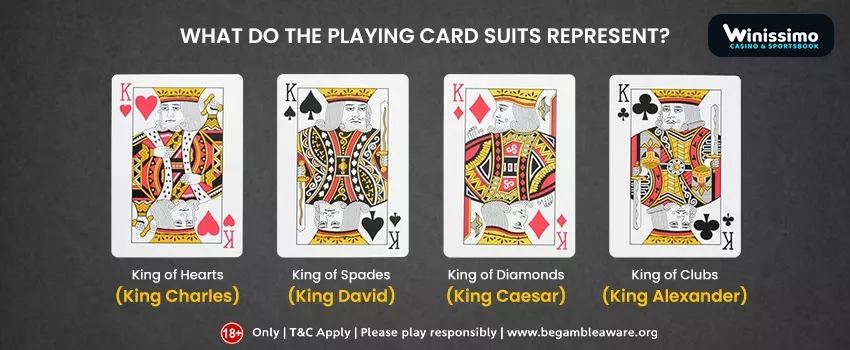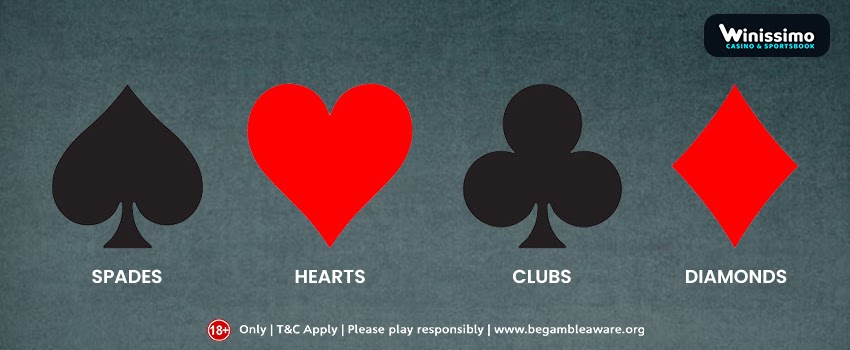Card games have always been a part of the history of casino games. In reality, several card games such as Online Blackjack, Poker, Teen Patti etc. have been housed in every online casino including Winissimo which is a trusted place to try out these games. Many of us will have played such games once in our lifetime. Some people still own a deck of cards to play with at home in their spare time. With friends or family members, a few rounds of a card game will certainly help relax your emotions, decrease tension levels, and lift your mood.

Card games are not only known as skill games but because of the profound astrological aspects veiled within the card symbols, they often communicate with us somehow.
Have you ever spoken about these traditional card-engraved symbols? Have you ever thought about the notion of using 4 suits on a deck? What is represented by each playing card? What is a diamond’s metaphysical meaning? What is the symbol of a spade?
Well, people do know how to play Blackjack or bridge today, but there are only a few pauses who realise that a card deck is a masterpiece in architecture, construction, and history. Cards have acted as amusing pastimes, high-stakes games, occult practise instruments, magic tricks, and models of mathematical chance, and as money at times and as a hidden message medium.
Different nations have modified card decks over the centuries so that the colours, emblems, patterns, and even the card names best represent traditions and cultures. In the United States, the symbols on the regular deck of English cards are called pips, and the four suits of hearts and diamonds in red and clubs and spades in black are currently shown on modern decks. Yet these suits and shades have had a long evolutionary past.
The Beginning
When the playing card was first created, there was no definitive authority on. Early records, however, indicate that in China and the late 1300s in Europe, the first playing cards may have been used as early as the late 1200s. Some sources state that as early as the ninth century, the first cards were used, but many reports still claim that the Chinese game of leaves that carries this title did not necessarily include cards, so people argue whether that should count as the beginning of playing cards.
It is assumed that the Chinese were the first to use appropriate money-based cards. Coins, strings of coins, myriads of strings, and thousands of myriads, were their suits. In the Middle Ages, in the 1370s, the Mamluks of Egypt changed them and passed them over to Europeans.
The four suits in a deck of modern English playing cards are generally thought to come from French decks of cards that were formed about 1480 from the Germanic suits.
The Germans developed their suits from their Latin suits. The names we are using are taken from English names, some of which are transferred from Latin suits.
Latin Suits

Cups, coins, clubs, and swords became Latin suits. In Italian, the word for sword is a spade, and in Spanish, Espadas, and that was continued in English. Ultimately, the ranking of suits presumably derives from the Chinese practice, which was related more specifically to merit.
Germanic Suits

The Latin suits were changed in the 15th century in the German-speaking territories. The Swiss-Germans used playing card suits to illustrate flowers, rings, acorns, and shields around 1450. However, these were converted to cores, bells, acorns, and leaves by the Germans. However, amid the alterations, the card suits appeared identical to each other.
French Suits

A variant of the Germanic suits is the French suits that now usually exist in the United States. They retained their hearts, but they used carreaux, which are tiles or diamonds, instead of bells. Interestingly, before the French decided on diamonds, there was a crescent suit instead of diamonds. The acorns turned into trèfles, standing for clubs or clovers. They had picks for pikes or spades instead of leaves.
The French suits reflect the four classes in one legend. Spades represent nobility, hearts stand for the church, vassals or traders represent diamonds, and peasants are clubs. Bells (who became the French diamonds) were the bourgeoisie of the German tradition, and leaves (who became the French clubs) were the middle class of merchants.
England gets France’s playing cards

Around 1480, French cards were shipped to England and the English brought their names from the older Latin suits for clubs and spades. In England, the importation of international playing cards was prohibited in 1628, so they started to manufacture their cards. In the 19th century, Charles Goodall and Sons reworked the French Rouen facial card designs to give us the common designs used today.
What do the four suits in a deck of cards represent:

Hearts: A heart reflects the spring season. It is often meant to be a reflection of human life’s ‘childhood’ period. It means the fire part.
Clubs: The club reflects the summer season. It denotes the stage of “youth” in which schooling, irresponsibility, etc. are stressed. The epitome of a part of the earth is a club symbol.
Diamonds: This emblem represents the fall or autumn season. It reflects the “growing” process of human life in which an entity aims for his/her career. In short, a diamond is an epitome of growth, duty, principles, protection, and so on. By this symbol, the aspect of air is represented.
Spades: The emblem of the winter season is a spade. It is known as an “old age” epitome when people learn experience, recognition, change, etc. This symbol signifies a water element.
A deck has a total of 52 cards that are meant to represent the number of weeks in a year. A single suit of 13 cards represents 13 lunar months. Of all the worth numbers on the cards, 365 is the sum. Each card’s value number characterises a keyword that informs us about the personality of the card.
What is represented by each playing card?
- An Ace represents Desire
- Two represents Union
- Three represents Faith
- Four represents Satisfaction
- Five symbolizes a Change
- Six represents Adjustments
- Seven represents the epitome of Victory
- Eight represents Power
- Nine represents New beginnings
- Ten symbolizes Success
Two additional “wild” cards are usually included in regular sets, each featuring a stereotypical court jester that can be used to trump any natural card. In 1867, Jokers first appeared in printed American decks, and by 1880, British card manufacturers, as it were, had followed suit. Interestingly, few games hire them. Perhaps, for this reason, the Joker is the only card that lacks an industry-wide, uniform style. The wily trickster, the seducer, the evil imp, a real calling card for the debauchery and fun that is the promise of card-playing, emerges by turns.
The cards of the royal family i.e. king, queens and Jack represent various historical figures.
King of clubs – Alexander(King of Macedonia)
King of Hearts – Charlemagne(King of France)
King of spades – David(King of Israel)
King of diamonds – Augustus(Roman Caesar)
The value of the cards has nothing to do with our real gameplay, but understanding those hidden information brings more and more fascinating layers to different card games.
Now let us see some card rankings in popular casino card games!
What is the order in Poker for card suits?
In Poker, all suits on the card are equal. In having the best hand, card suits play no part. The Ace is the highest card in Poker, and the 2 (Deuce) card is the lowest. The Ace can, however, also be used as a small card, with a value of 1.
What is the order of suits in Blackjack?
In offline/online/Live Blackjack, the suit isn’t significant. It’s just fun to remember. When playing Blackjack, the part of the card that matters is the value of the total. You should obtain that their card worth is equal to the exact amount they serve with the actual numbered cards. Cards 2 through 10 reflect the number, no matter the suit.
A King, Queen, or Jack, face cards have a card score of 10. The Ace card is special, which can have an 11 or 1 card value-nothing in between, either a solid 11 or a solid 1. And you’re going to pick!
There are many strategies that you can use while playing Blackjack to increase your odds of winning like doubling down and card counting.
Summary
One can quickly forget the importance of cards as having no usefulness in day to day applications. Playing cards are seen as a leisure sport for most people. That being said, there are many advantages to playing cards. They hold a deeper meaning and help in developing many skills in the players.
